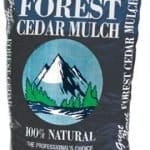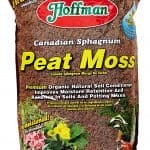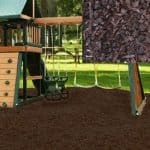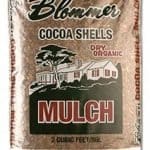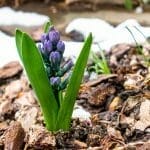
Below is a mulch for garden quick guide, where I provide the benefits, the types, and how much mulch to use among other things.
What is mulch and what are the benefits of using it in the garden?
Mulch is a material that is spread on the surface of the soil. It is used to protect the soil from erosion, conserve moisture, and improve the appearance of a planting bed. But it is also used as great protection against weeds.
In essence, mulch can be a great way to keep your garden cool, help preserve soil moisture levels, and deter unwanted plants to grow.
There are many different types of mulch, so it’s important to choose one that will work best for your garden.
Some common types of mulch include dried leaves, straw, bark chips, wood chips, and compost.
Types of mulch: What are the different main types of mulch available to gardeners?
As mentioned above, there are so many different types of mulch available to gardeners, each with its own unique benefits. Some of the most common types of mulch include:
- Bark chips, which are made from the bark of trees;
- Shredded wood, which is made from wood that has been ground up into small pieces;
- Compost, which is made from decomposed organic matter such as leaves, grass clippings, and selected kitchen waste;
- Plastic sheeting or landscape fabric are used to prevent weeds from growing. This is the least favorite option among the different types of much.
What you can take from the above different types is the following:
You can use any type of organic material to produce your own mulch, but wood chips, bark, leaves, or straw are the most popular. For instance, Straw mulch is really good for mulching tomatoes.
How to use mulch: Tips on how to use mulch in your garden for maximum benefit.
Obviously, laying mulch is a practice that can provide your garden with many benefits.
By properly using mulch in your garden, you’ll create a happy garden. So here are some tips on how to use mulch in your garden for maximum benefit:
1. Use and choose the right type of mulch:
This is probably the most important criterion. Not all types of mulch are created equal, so it’s important to choose the right one for your garden.
Organic mulches, such as wood chips or straws, are good for adding nutrients to the soil and helping to control weeds. That’s probably the best choice for most gardens and I would go as far as saying it is best to use shredded hardwood bark.
This type of mulch has a natural acidity that helps it to break down over time, releasing nutrients as it breaks down.
2. Choose the right depth of mulch:
Too much mulch is not good, but too little too.
Too much mulch means that your garden will not breathe. But putting too little is simply saying to the weeds, hey here is some mulch that will feed you good “food” (as a fertilizer as it breaks further down).
So if you do not want weeds, ensure to lay enough mulch.
How Much Mulch Do I Need?
Let’s first look again at the basics: Mulch is a layer of material, usually organic, that is spread over the surface of the soil.
We know that it helps to conserve moisture, improve the fertility and structure of the soil, and suppress weed growth.
The amount of mulch you need will depend on the area you are covering and the thickness of the layer you want to create.
A general rule of thumb is to apply a layer of mulch that is 2-4 inches (5-10 cm) deep.
To calculate the amount of mulch you will need, first measure the area you want to cover.
For example, if you are covering a 10-foot by 10-foot (3-meter by 3-meter) area, this equals 100 square feet (9 square meters).
Next, decide on the thickness of the layer of mulch you want to apply.
If you want a 2-inch (5 cm) deep layer, you will need 0.2 cubic yards (0.15 cubic meters) of mulch.
This can be converted into 2 bags of mulch (each bag covers 0.1 cubic yards or 0.075 cubic meters).
3. When to apply mulch: Advice on when is the best time to apply mulch to your garden.
Most people recommend applying mulch in the spring before the plants start growing.
This will help to protect them from the elements and help the soil stay moist. You can also apply mulch in the fall, but it’s important to make sure that the ground is not frozen or too wet.
If you are using organic mulch, such as compost or straw, it’s important to re-apply it every few weeks as it breaks down very quickly.
Is it necessary to place new soil down before placing the mulch?
There are a couple of things you need to do before you put down your mulch.
One of those things is to make sure the soil is in good condition. If the soil is not in good condition, then you need to place new soil down before putting down the mulch. So yes, it is best to put new soil down before placing your mulch in case your soil is not of good quality.
One of the best pieces of advice we can give you is as follows:
If you have a garden that is full of weeds, then you will need to remove them before putting down the mulch.
As soon as you removed the weeds, then lay down your mulch. Mulch will help to suppress future weed growth, but it will not get rid of them all. You’ll always have a few weeds growing here and there. But it’ll definitely be a very small number that you can remove once in a long while.
You also need to make sure that the soil is moist before putting down the mulch. If it is not, then you can water it first.
What is Inorganic Mulch?
Inorganic mulch is a material that is applied to the surface of the soil.
It is used to improve the appearance of the landscape, protect plants from extreme weather conditions, and suppress weed growth.
Inorganic mulch materials include gravel, stones, shells, and recycled glass.
What is Organic Mulch?
Organic mulch is a layer of organic material, such as compost, leaves, straw, or bark that is spread on the surface of the soil.
Organic mulch helps improve soil structure, moisture retention, and fertility.
It also helps suppress weeds and reduce erosion.
Note that it is best to use organic mulch rather than inorganic ones.
What is a biodegradable mulch?
Biodegradable mulches are those that will decompose over time, providing nutrients and organic matter to the soil. Basically, a biodegradable mulch is an organic mulch (see above section).
Again, there are many different types of biodegradable mulches available, including organic materials like straw, compost, and shredded bark.
The benefits of using a biodegradable mulch include improved soil health, reduced water usage, and decreased weed growth. Biodegradable mulches also help to moderate the temperature of the soil, which can be beneficial in areas with extreme temperatures.
What is a non-biodegradable mulch for your garden?
There are many different types of mulch, but not all of them are biodegradable.
Non-biodegradable mulches are made from materials that will not decompose over time. They are also known as non-organic mulches (see above section).
This type of mulch is often used to prevent weeds from growing and to keep soil in place. Non-biodegradable mulches can be made from a variety of materials, including plastics, rubber, and stones.
While non-biodegradable mulches do not break down over time, they can still have benefits for gardens. They can help to suppress weeds, reduce moisture evaporation, and improve soil structure.
What is Sheet Mulching?
Sheet mulching is a gardening technique that can be used to improve the soil, control weeds, and help retain moisture in the garden.
It involves laying down a layer of organic material, such as straw, leaves, or compost, and then topping it with a layer of soil.
The organic material decomposes over time, creating a rich, fertile soil that can be used for planting.
Sheet mulching is also an effective way to control weeds, as the layer of organic material will smother any weed seeds that are present.
Finally, the reason sheet mulching technique can help retain moisture in the garden is that it slows down the evaporation from the soil.
Mulch for garden quick guide – Conclusion
Mulch can be a great way to cover your garden soil and prevent weeds from growing. There are many different types of mulch, so you can find one that is specific to your needs.
Some mulches are made from natural materials, like wood chips or bark, while others are made from synthetic materials, like plastic or bitumen.
Mulch can also help to improve soil fertility and cool the soil in the summer.
Each has its own advantages and disadvantages.
Some materials may need to be replaced every few years as they break down, while others may last just a couple of weeks and require replenishing. In general, organic mulches are best for maintaining soil health.

